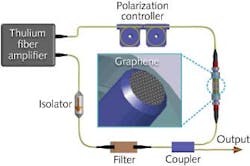Ultrafast modelocked mid-infrared (mid-IR) lasers are of great interest due to their potential in applications ranging from medicine and environmental monitoring to materials processing and free-space optical communications. The most common technique to modelock these lasers relies on semiconductor saturable absorbers that require expensive growth techniques, often combined with ion implantation to reduce response time, and do not allow broadband operation. Novel nonlinear optical materials working in the mid-IR with better performance, cheaper fabrication, and easier integration are thus of interest.
Researchers at Cambridge University (Cambridge, England) and Imperial College London (London, England) have demonstrated that graphene is a promising broadband saturable absorber with ultrafast response time, easy fabrication and integration, and mechanical and environmental robustness. When used as a modelocker for ultrafast thulium-doped fiber lasers emitting at 1.94 μm, graphene can generate 3.6 ps laser pulses at a repetition rate of 6.4 MHz and approximately 0.4 nJ of energy with 6 ps timing jitter. Another collaboration between Cambridge University and the University of St. Andrews (Fife, Scotland) exploits single-layer graphene to modelock a high-power (270 mW) ultrafast (transform-limited 410 fs) solid-state laser at 2 μm. These results showcase the great potential of graphene for simple, low-cost, stable mid-IR ultrafast solid-state and fiber lasers. Contact Andrea C. Ferrari at [email protected].
About the Author

Gail Overton
Senior Editor (2004-2020)
Gail has more than 30 years of engineering, marketing, product management, and editorial experience in the photonics and optical communications industry. Before joining the staff at Laser Focus World in 2004, she held many product management and product marketing roles in the fiber-optics industry, most notably at Hughes (El Segundo, CA), GTE Labs (Waltham, MA), Corning (Corning, NY), Photon Kinetics (Beaverton, OR), and Newport Corporation (Irvine, CA). During her marketing career, Gail published articles in WDM Solutions and Sensors magazine and traveled internationally to conduct product and sales training. Gail received her BS degree in physics, with an emphasis in optics, from San Diego State University in San Diego, CA in May 1986.
